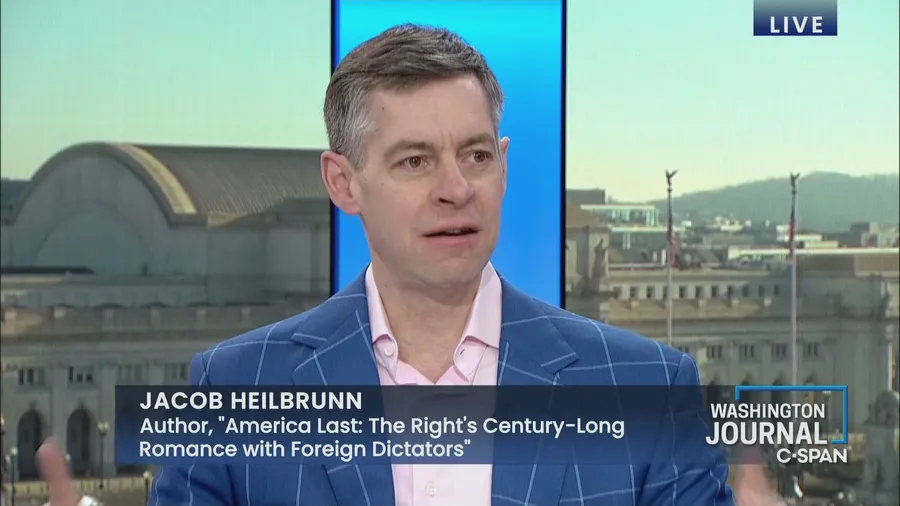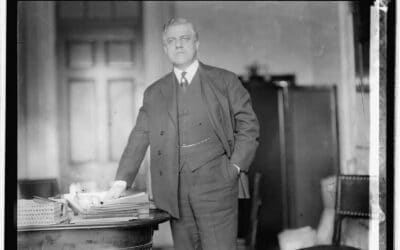The Western commentariat has spilled much ink and expended considerable effort attempting to explain our era of political malaise, particularly the disruptions underway within the Republican Party and the American Right. It is into that maelstrom that Jacob Heilbrunn seeks to explain the Republican Party’s alleged turn towards illiberalism. Heilbrunn’s America Last: The Right’s Century-Long Romance with Foreign Dictators is a meandering and often ahistoric examination of the American Right and its affinity for authoritarian or illiberal overseas regimes. Heilbrunn’s central question is to determine why today’s Republican Party is attracted to the illiberal politics of autocrats like Russia’s Vladimir Putin and Hungary’s Victor Orban, the latter with whom he opens his book.
Heilbrunn, however, throughout his work, posits that since the 1910s, the American Right has always harbored deep sympathies for right-wing authoritarians abroad and sought to mobilize such politics at home. Heilbrunn’s book is, however, really two books in one, the first of which pursues his stated goal and a second which serves as a full-throated defense of an orthodox narrative of American foreign policy, one which he asserts is perpetually under assault by the antagonists of his study. The awkward marriage of these two goals, coupled with its expansive scope, makes for a deeply flawed examination of the subject matter, which leans heavily upon proof by verbosity, conflates otherwise disparate political actors and makes little effort to historize or empathize its subjects.
America Last is comprised of nine chapters that constitute an ambitious scope, the entirety of American foreign policy and its domestic facets from World War I until the present day. Heilbrunn begins his book with two chapters concerning the First World War, then covers the interwar period and the Second World War in three chapters, dedicates another three chapters to the Cold War, and speeds through the 1990s until the present with his final chapter and conclusion.
Regarding the book’s primary goal, Heilbrunn’s results are mixed. Where Heilbrunn is strongest in his treatment; he sticks to a discrete set of historical actors and their ideological relationships with selected overseas dictators and shows how those relations carried on throughout the twentieth century. Heilbrunn’s treatment of Lawrence Dennis’s early life and career is particularly enlightening. Heilbrunn catalogs how the biracial Dennis passed well enough to become, according to Life, “America’s No. 1 intellectual Fascist.” Heilbrunn further skillfully narrativizes how Dennis’ early career as a diplomat in Latin America instilled in him an affection for the prototypical strongman and a skepticism for the ability of non-whites to achieve republican self-rule (a view that Heilbrunn rightly notes creeps down through the decades). Dennis’s own racial identity makes his conclusions all the more tragic, but perhaps fitting for a country still coming to grips with the relationship between race and republicanism, a domestic issue amplified by the totalitarian horrors then unfolding abroad.
Heilbrunn’s material on Francisco Franco and his American backers is also valuable for those unread on the era. He shows how, in the 1930s, American admirers latched on to Franco and stuck with him throughout the Cold War. To his credit, Heilbrunn’s material on Franco and his American devotees examines how the Spanish generalissimo symbolized the struggle “between godless communism and Western Christendom.” Heilbrunn shows how American Catholics found in Franco an outlet for their domestic anxieties concerning communism and its related atheism and how Franco’s victory and presence continued to inspire conservatives throughout the twentieth century.
Heilbrunn’s narrative of the war is, however, relatively flat and provides none of the details that motivated American Catholics to rally around Franco, such as the Red Terror, when factions of the Spanish Republicans killed an estimated 50,000 people, including 6,000 members of the Catholic clergy. It should go without saying that the Nationalists’ hands were far from clean, but such atrocities are necessary for understanding Franco’s enduring appeal. This is a reoccurring issue with Heilbrunn’s material as his subjects’ motivations are often obscured. Perhaps such oversights can be forgiven when it comes to literal fascists like those in the German American Bund or the Silver Shirts, but as Heilbrunn’s narrative draws closer to the present, his lack of historicism makes for a book that reads more like a polemic than a work of disciplined journalism or history.
Issues with Heilbrunn’s lack of historical thinking compound with a wondering scope and conflation of disparate political actors and phenomena, an extensiveness that strains his thesis. Heilbrunn’s work features a dizzying array of subjects, which includes everyone who may have looked askance at the New Deal or liberal internationalism such as the crypto-anarchist H.L. Mencken, German propagandist George Sylvester Viereck, self-avowed fascists such as the aforementioned Lawrence Dennis, and populists like Senator Joesph McCarthy. Heilbrunn also folds in relatively mainstream figures, like Old Right and non-interventionist stalwart Robert A. Taft, and liberal Republican hawks like Henry and Clare Booth Luce. Heilbrunn also shoehorns in New Right luminaries like William F. Buckley and Marvin Liebman into his crowded field, and many, many…many others.
Among those contemporary figures that he muscles into his rogue’s gallery are post-liberals like Adrian Vermeule and Sohrab Ahmari. Placing a columnist like Ahmari or a legal scholar such as Vermeule in the same ideological tradition that gave birth to the Silver Shirts or Father Coughlin is not only ahistorically absurd but also misses significant social and economic fissures within the modern Right. Such is especially the case for Ahmari, who has taken public stances against racial identitarianism and eugenics, two issues that Heilbrunn (rightly) weaves throughout his narrative. Furthermore, looking towards illiberal regimes overseas for inspiration in handling modern political matters such as abortion, immigration, or trans issues is not derivative of those past ne’er do wells who lauded eugenic sterilization, street violence, or the Holocaust. The only common dominator shared with some of Heilbrunn’s antagonists is that they oppose a liberal project he supports (although never clearly defined), albeit in their separate eras and for their own reasons.
Beyond his choice of subjects, much of his material seems out of place either on its own merits or because Heilbrunn fails to inform the reader how it fits into his larger argument. Such is the case for much of his Cold War material, particularly his chapter on Jeane Kirkpatrick. While indeed Kirkpatrick and the first generation of neoconservatives cozied up to the world’s authoritarian regimes, they did so less for ideological than for geopolitical purposes. Furthermore, such dealings with Cold War strongmen did not emerge solely from the moral failings of the Right. Instead, the demands of Cold War liberalism lay at the heart of the U.S. government’s deals with devils. It was the liberal Truman and “moderate” Eisenhower administrations that first began arming and aiding rightwing dictators such as Franco, Salazar, and, indeed, the communist Tito regime. Furthermore, in the early days of the Cold War, it was the “isolationists” of the Old Right who most stridently opposed the Mutual Security Act and other Cold War initiatives that made it possible to prop up the litany of Cold War strongmen. The moral landscape of the Cold War was far more complicated than Heilbrunn presents.
The other objective of Heilbrunn’s work is to resurrect a liberal orthodox interpretation of American foreign policy…at least as far as the World Wars and contemporary history are concerned. To achieve this, Heilbrunn attempts to deconstruct the practice of historical revisionism and argues its influence is “central to the Right’s romance with foreign dictators.” While he justifiably criticizes the hyperbole of past revisionists who saw malice throughout American foreign policy, Heilbrunn instead overcorrects with myopic orthodoxies and abject presentism. In doing so, he pays lip service to or outright ignores egregious assaults upon democracy at home that came as a cost to waging wars abroad, thereby stripping American revisionism of its domestic context. His (mis)treatment of historical revisionism is not merely an academic oversight as his characterization of the practice serves as an evidence base, one that he mobilizes to argue that the desire to keep out of wars overseas is adjacent to rightwing illiberalism.
Heilbrunn’s efforts to counter historical revisionism start with his first two chapters, which concern the run-up and fallout of American entry into the Great War. Heilbrunn rightly notes World War I revisionists exaggerated “the extent to which Wilson and his advisers could control events” and downplayed the presence of German sabotage upon American soil. Yet, Heilbrunn downplays Wilson’s agency and that of the United States government’s incremental entry into the war and financial incentives on the part of American lenders and the desires of the Wilson White House. Instead, Heilbrunn offers a sophomoric narrative of the war where the Allies were merely reactive players against a uniquely evil German empire. He attempts to shore up his version of events with a counterfactual that, absent American entry the war would have eventually “led to a direct military confrontation between Berlin and Washington.” How imperial Germany could have redeployed their stalemated forces out of a two-front meatgrinder and goosestepped across the Atlantic is left to the reader’s imagination.
Heilbrunn’s dismissal of revisionism and its antecedents continues in his treatment of the war’s impact on the home front. While, to his credit, he briefly introduces the reader to the Committee of Public Information (CPI), the U.S. government’s official (and extra-legally created) propaganda agency, he fails to connect its abuses to the subsequent rise of historical revisionism. The CPI, coupled with the Sedition Act and state-sanctioned vigilantism, culminated in arguably the worst civil rights abuses in twentieth century American history. While he mentions the fires of anti-German sentiment stoked during the war, he breezes right through such abuses. Heilbrunn similarly omits the longer history of Anglophobia, a phenomenon he invokes but provides no context to. While again, he makes passing references to American concerns about British propaganda (concerns he waves away), there was, in fact, a robust and illegal British effort to influence American public opinion, the revelations of which contributed significantly to the climate of postwar anguish and, therefore, historical revisionism. Wilson’s desire to secure democracy abroad, however sincere, resulted in its annulment at home. It was in this seedbed of trauma that historical revisionism sprang forth, anguish that Heilbrunn apparently has little sympathy for.
Similar oversights permeate Heilbrunn’s coverage of the Treaty of Versailles and its ratification failure in the United States Senate. While he rightly notes that the treaty drew howls from “isolationists,” he neglects to mention the mechanics of the treaty’s defeat, specifically that of the Lodge Reservations. Senator Majority Leader Henry Cabot Lodge Sr. (whom Heilbrunn introduces via a non-sequitur concerning Lodge’s nativism) offered a series of compromises to the Treaty of Versailles meant to assuage sovereignty concerns, anxieties that Heilbrunn dismisses. Woodrow Wilson, who was every bit the elitist as many of Heilbrunn’s antagonists, roundly dismissed negotiation, much to the dismay of Wilson’s closest advisors. The defeat of Wilsonianism had as much to do with the stubbornness of its namesake as it did with the blinkered views of American “isolationists.” Heilbrunn sums up his treatment of the First World War and its aftermath with a confident declaration that “Wilson, for his conduct of the war and its aftermath, he had it right,” coupled with the lament that “[i]solationism was in” after 1919.
“Isolationism,” like “democracy” and “liberalism,” is one of the many cudgels he swings but never defines. Parenthetically, one should note that the United States was not ‘”isolated” in the interwar period in any meaningful sense. Uncle Sam retained colonies throughout the Pacific, exercised hegemonic power over Latin America, entered arms control treaties, and maintained robust trading relationships worldwide. For an isolated nation, the United States of the 1920s and 1930s sure got around. While one can admire Heilbrunn’s chutzpah in attempting to rehabilitate an almost universally reviled war, his analysis and omissions make for a poor footing for understanding the heyday of American “isolationism” and its reciprocal relationship with historical revisionism.
Upon this rickety foundation, Heilbrunn approaches historical revisionism and its influence on American debates around World War II and the subsequent right-wing revisionist movement. In his coverage of the waning days of American neutrality, Heilbrunn correctly notes that the Right viewed the Soviet Union as a more significant threat to the United States and the larger West. But he also conflates those whose motivations stemmed from a genuine affinity with National Socialism with those who viewed it as a lesser of two evils.
While Heilbrunn disapproves of such a view and uses it to rope disparate political actors together across his book, his analysis reveals his presentism and inability to engage objectively with his subjects. By 1939, the Soviet Union had revealed itself to be a totalitarian regime, one that helped to start the Second World War with its joint invasion of Poland with Nazi Germany, swallowed up the Baltic States, and invaded Finland. With Hitler’s betrayal of Stalin via Operation Barbarossa, the moral waters of war were indeed muddied, and not just for the fringes of the far right. The turn of events in the summer of 1941 influenced the thinking of disparate figures like Herbert Hoover, Harry Truman, and progressive historian Charles Beard, who all viewed the war in the East as a fight between two equally evil totalitarian systems. Heilbrunn conflates this view of the war with perspectives, like journalist William Henry Chamberlain’s horror at the Allied use of indiscriminate aerial bombing or criticisms of unconditional surrender, and more noxious narratives like historian Harry Elmer Barnes’s descent into Holocaust denial. In subsequent chapters, Heilbrunn uses this conflation to judge individuals’ stances on World War II as evidence of the Right’s affinity for contemporary dictatorship, one of his many turns towards ahistoricism.
Throughout his material on the Second World War and its impact on the home front, Heilbrunn does not mention the U.S. government’s wave of undemocratic and illiberal activities to suppress constitutionally protected speech and association. Instead, he attempts to approvingly breathe new life into a historical phenomenon known as the “Brown Scare,” a phrase coined by historian Leo Ribuffo in his classic, The Old Christian Right, a work Heilbrunn cites only once and only to dismiss. Heilbrunn asserts that “there really was something to be scared about” and that the “notion that Nazism in America was mythical was itself a myth.”
However, in his treatment of the topic, which is predicated upon a thin reading of Bradley Hart’s recent Hitler’s American Friends, Heilbrunn displays a fundamental misunderstanding of the Brown Scare thesis, which does not hold that the presence of fascist sympathizers in America was mythic, but that their influence was grossly exaggerated and set precedents that were abused throughout the twentieth century. While Heilbrunn lauds FDR for warning Americans about “fifth columnists,” had he engaged with the body of works concerning the Brown Scare such as Insidious Foes by Francis MacDonnell or Douglas M. Charles’s J. Edgar Hoover and the Anti-interventionists (among many others) he may have known that such fears were amplified by an illegal domestic espionage campaign on the part of the Federal Bureau of Investigation, and, once again, British intelligence. As with World War I, American entry into World War II sacrificed liberty at home to advance it abroad, and again, this tradeoff provided ample grist to the mills of historical revisionists.
Turning to the present, Heilbrunn again disapprovingly notes that revisionism “remained rampant” on the Right, polluting American retrospectives on NATO expansion and contemporary discourse concerning Vladimir Putin and his designs in Eastern Europe. His perspective on the present is as inflexible as his treatment of the past. He only briefly concedes that overseas adventures like the Iraq War “become synonymous with…arrogance, hubris, and bellicosity.” A more thoughtful shakedown of recent events on his part could have led to the conclusion that thousands of wasted lives, trillions of wasted dollars, and a mountain of deceits on the part of the federal government have understandably breathed life into a new wave of historical revisionism, one that was seized upon by vacuous political opportunists like former President Donald Trump.
Heilbrunn laments that Trump, while on the 2016 campaign trail, sought to rehabilitate Putin’s image and that the GOP was “capitulating” to his revisionist views. But if a candidate espouses political views and constitutionally protected speech within the confines of a democratic process, is that not itself emblematic of democracy, the very system that Heilbrunn purports himself to be standing up for? Rather than empathize with his subjects, Heilbrunn assumes the worst of their motives and rarely stops to assess whether American policy failure at home or abroad drives events. Unfortunately for the reader, as noted above, Heilbrunn never defines democracy nor the political activities he includes therein. Whatever his definition, he clearly doesn’t count debating war and peace as being among them.
The preeminent American poet Robert Frost once quipped that a “liberal is a man too broadminded to take his own side in a quarrel.” By that metric, Jacob Heilbrunn’s America Last is not a work of liberalism, as Heilbrunn assuredly believes his political tribe to be on the right side of history. His subjects are his flat, often psychologized antagonists, mere caricatures who seek to “bludgeon into submission” Americans they disagree with. However, Heilbrunn is correct in one respect: the postwar liberal order is cracking at home and abroad. Yet his work does little, if anything, to unpack the motivations of those who seek to tear it down. Perhaps liberalism is already dead, as Heilbrunn couldn’t find enough to spare for his own treatise. If you are looking for a book to help make some sense of how we got here, a work that studies the views of other Americans with a modicum of empathy, then Jacob Heilbrunn’s America Last: The Right’s Century-Long Romance with Foreign Dictators is not for you.
































